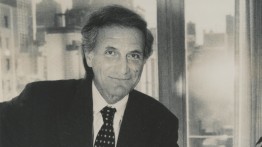Bob Scudellari A'55

Graphic designer Robert (Bob) Donald Scudellari A'55 died on June 3, 2022, after a prolonged illness. Scudellari was best known in the design community for the bold typographic book jackets he produced during his 26-year tenure as Vice President and Corporate Art Director at Random House during the 70’s and 80’s. His design work for important authors such as Toni Morrison, John Cheever, and the Modern Library series was rooted in a passion for typography and calligraphy. Often working with lettering artists such as Tom Carnase, and Gun Larson, Scudellari would finesse the ligatures, kerning, and leading of his type to create dynamic designs that were immediately recognizable — what we now call a “brand.” In his design work, he had an exceptional talent for capturing the spirit of the literature, interpreting its essence visually. For some authors such as John Cheever, Toni Morrison, and Ann Rice he carried this design logic forward through several books, giving the author a distinctive, easy-to-recognize, and dynamic look.
Scudellari's design systems branded the Random House Modern Library, and the Library of America, grouping their legendary authors into a collectable series. He designed several of the exquisite Ballet coffee table books that Bob Gottlieb (Knopf Editor-in-Chief) published while working closely with Balanchine on the NY City Ballet. His jackets were powerful and iconic, bringing significant value to the publisher and author alike. Bob Gottlieb commented of The Library of America Series he worked on after he retired from Random House “He designed the unique look which they deployed effectively since its very inception.”
Bob won many AIGA 50 Book Awards for his jackets and books, influencing countless other designers and illustrators. He always found time to design as well as oversee 5 art directors of various imprints under the Random House umbrella including Knopf, Pantheon, Vintage and the development of many museum co-publications.
Born in Queens on June 9, 1933, Scudellari was the son of a New York City fireman and was an aspiring basketball player with a twinkle in his eye. Along with shooting hoops, he loved to draw. For many years his two passions developed side by side as he made his way to New York's famous and free art school, The Cooper Union. While attending Cooper, he joined the basketball team and was eventually drafted by the Boston Celtics. However, Scudellari abandoned basketball and instead took a job as a book designer in Manhattan. During this time Scudellari started a family with his wife and fellow Cooper student Edith Ondik.
Scudellari had a short stint at Dell Publishing before he went into the army to serve during the Korean War, working as a medic and signage designer. During that time he traveled the world but did not see active duty.
Bob loved people, most of all designers, illustrators, suppliers, authors, and typographers, the people in the business were an inspiration. Bob was an unusually kind person, giving young inexperienced designers and illustrators a break, mentoring them patiently to create a new generation of art directors. He always looked for the best in everybody and found a way to get along with some of publishing’s most irascible personalities. Also, a wonderful father, Scudellari often spoke of taking his children and wife to special places around the city where they would sit and draw for long afternoons on the weekends.
Eventually, with the appearance of computers, Bob reached a crossroad. Like some, he was unwilling to give up his pen for a mouse, instead choosing to walk away from "desktop publishing" as he called it.
Bob was predeceased by his wife Edith, and survived by his two children, Regina A.E. Scudellari-Ponemon and Robert Scudellari ll. For more information, click here, here and here.




